 19 Oct 11
19 Oct 11 20 Oct 12
20 Oct 12 5 Dec 10
5 Dec 10 14 Jan 11
14 Jan 11 9 Dec 10
9 Dec 10[ Home ] [ Up ] [ Previous Page ] [ Next Page ]
Digitrax makes a full line of DCC decoders for small and large scale use. Their designs are mostly aimed at track powered DCC, not direct radio control like Airwire. Digitrax provides walkaround radio control via trackside receivers that relay the commands to the command station. The commands are then mixed with commands coming from wired throttles and sent to the track.
However, there are three models of decoders that are specifically intended for use in large scale locomotives and an inexpensive HO sized decoder that will work in SOME smaller large scale equipment. They also make sound and function decoders that are designed to work in tandem with a regular motor and function decoder. These are called the "Soundbug" series however, their audio output power is really too low for outdoor use.
Digitrax decoders follow the NRMA standards that were defined at the time each decoder was built. They will work with any DCC command station. The newer ones are full featured with a complete programming set and work quite well. However, the older ones don't do so well and have some problems.
To see other pages on this site where various Digitrax decoders have been used, my DCC Tips pages. Look toward the bottom for a table of example installations.
 19 Oct 11
19 Oct 11 20 Oct 12
20 Oct 12 5 Dec 10
5 Dec 10 14 Jan 11
14 Jan 11 9 Dec 10
9 Dec 10Digitrax has been making decoders for many years, they were one of the first and are still have a fair chunk of the market. Their decoders have one of the better cost/feature ratios of any manufacturer. Their street prices run from about $16 to about $54 for motor and function decoders. Some sound decoders are a little more expensive, but not by a lot.
Current production Digitrax decoders vary in size, motor drive capability and the number of functions but most of them run the same, or at least similar, firmware. Most of them are silent running, have BEMF motor control and special function generators assignable to each function output. The special functions can be used to make a light into a Mars light, Gyralight, strobe, FRED, or flickering firebox. Most decoders offer remapping of function outputs to allow functions to be combined and/or assigned to different keys on the throttle.
Digitrax has a decoder part number assignment scheme that pretty much describes the decoder based in it's part number.
The first letter in a part number, like DG583S, is "D" for decoder, "S" for sound or "F" for function. If it is "SF" it means that it does both sound and functions.
The next letter usually represents the scale that the decoder is intended for, these will usually be "Z", "N", "H", or "G". The G scale decoders are also used for O gauge and can be wired to drive typical AC motors.
The first number in the part number is the number of amps, rounded down to the nearest amp, that the entire decoder is good for. This is the average motor current, NOT stall current, and INCLUDES the rated function currents. Stall current was important when the decoders used a low PWM frequency to drive the motors. The newer decoders use very short pulses and the peaks of the pulses will not reach the true stall current because of current limiting caused by the motor's own inductance. Stall current is typically not an issue anymore as the decoders are sized for a stall current that is adequately higher than the running current.
If the first digit in the part number is a "O", then the decoder is NOT intended to drive a motor, it will provide sound or extra functions controls.
The next digit is the number of functions. Headlights count for two. On the newer decoders, each function can have some special attribute applied to make lighting do something special.
The third digit is the "series" of the decoder. In large scale anyway, the decoders became useful at series 3.
The last letters or numbers provide some additional information, usually pertaining to the connectivity of the decoder. "S" means screw terminals, "D" is plain wires, "AR" indicates a plug and play decoder for AristoCraft or Bachmann DCC sockets. "L" stands for Lionel as this kind was designed to be able to drive Lionel or American Flyer AC motors in addition to G scale DC motors.
The smaller decoders typically come wrapped in shrinkwrap. The recent larger ones have an aluminum plate fastened to one or both side(s) to provide a heat sink for the rectifier diodes and motor driver switches.
The following sections pertain to specific decoders that I have used at one time or other in large scale trains.
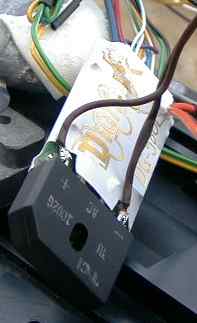 The DG580L is an older design. I have three of them, they are currently in the DCC parts box because they are really not suitable for use. These decoders were SUPPOSED to be capable of running the largest of the large scale locos, but in practice, they just didn't cut it. Over a period of 10 years, I've installed and then replaced them in over a dozen locos because their performance has just been unsatisfactory. However they are useful to test a new DCC installation when the decoder that is intended to be used is on backorder, which they often are. If I mess up and cremate one of these parts, it is no great loss. If the installation basically functions, then I can be pretty sure that when the real decoder comes, it'll work just fine. The 9 pin function header is nominally the same pinout as the newer decoders, described below, so that much of the function wiring will work as well. There is one nagging problem though, see the section on the DG583S below for the gory details.
The DG580L is an older design. I have three of them, they are currently in the DCC parts box because they are really not suitable for use. These decoders were SUPPOSED to be capable of running the largest of the large scale locos, but in practice, they just didn't cut it. Over a period of 10 years, I've installed and then replaced them in over a dozen locos because their performance has just been unsatisfactory. However they are useful to test a new DCC installation when the decoder that is intended to be used is on backorder, which they often are. If I mess up and cremate one of these parts, it is no great loss. If the installation basically functions, then I can be pretty sure that when the real decoder comes, it'll work just fine. The 9 pin function header is nominally the same pinout as the newer decoders, described below, so that much of the function wiring will work as well. There is one nagging problem though, see the section on the DG583S below for the gory details.
This decoder has several problems which make it unsuitable for extended use.
Noise. The low PWM frequency, about 30 Hz, that these decoders use makes a terrible racket. They grumble and growl something fierce. The noise is truly annoying.
Unreliability. All three of these decoders will not run reliably. When there is too much noise on the track, more than a couple of volts p-p, these decoders freak out and just stop working. They may act completely or partially dead on the main, but respond on the programming track. They will usually analog convert when they get weird indicating that they haven't physically failed, but they do not respond properly to DCC commands. Simply going to OPS mode and resending the decoders address back to it will bring it back to life for awhile.
Heat. These decoders cannot actually handle their rated current, at least not at the motor output. They get really hot and current limit at much less than 5 amps. Digitrax decoders are rated for INPUT current. That means that if the decoder says that it is good for 5 amps, it assumes that the functions are all loaded up to spec. This decoder has one 1 amp function output and seven 200 mA outputs. This makes 2.4 amps of available function current, leaving just 2.6 amps of capability for the motor. It might not even do that much.
| Locomotive | Link | Notes |
|---|---|---|
| Lionel Atlantic | Lionel Atlantic Tips | Pulled after two years for poor pulling performance and noise. |
| Aristo RS3 | RS3 Tips | I did installs in two RS3's. One failed outright and the other was removed because it made too much noise. |
| Aristo Pacific (old version) | Pacific Tips | Pulled for unacceptable performance and noise. |
| LGB 2060 | DCC Installation in the 2060 | Pulled after about a year because the loco didn't have good enough power pickup to use DCC on dirty track. Also made a lot of noise. |
| Aristo 0-4-0 | Aristo 0-4-0 Tips | Pulled for noise and flakey performance. |
| Aristo Doodlebug | Aristo Doodlebug Tips | Noisy, failed after a while |
| Aristo C-16 | DCC Installation in the C-16 | Didn't make much noise in this loco but was totally unreliable. |
| Lionel Handcar | DCC Installation in the Lionel Handcar | Pulled for too much noise. |
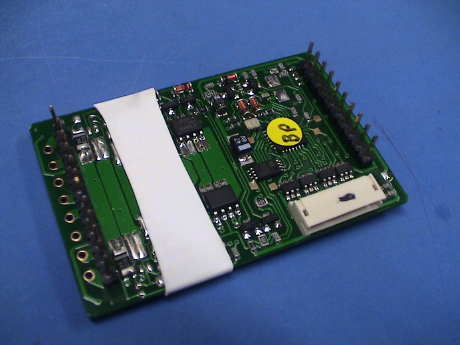 AristoCraft has been using a "Plug and Play" 12 pin socket on most new locos since about 2001 or so. Bachmann has recently started using a similar socket. The DG383AR (and larger DG583AR) is designed to fit into this socket. There MAY be some problems with the headlights matching the loco direction in some locos. This can be fixed via function remapping on the Digitrax decoders. QSI decoders will fit in the same socket as well as AristoCraft 75 MHz Train Engineer radio receivers and some RCS radio receivers.
AristoCraft has been using a "Plug and Play" 12 pin socket on most new locos since about 2001 or so. Bachmann has recently started using a similar socket. The DG383AR (and larger DG583AR) is designed to fit into this socket. There MAY be some problems with the headlights matching the loco direction in some locos. This can be fixed via function remapping on the Digitrax decoders. QSI decoders will fit in the same socket as well as AristoCraft 75 MHz Train Engineer radio receivers and some RCS radio receivers.
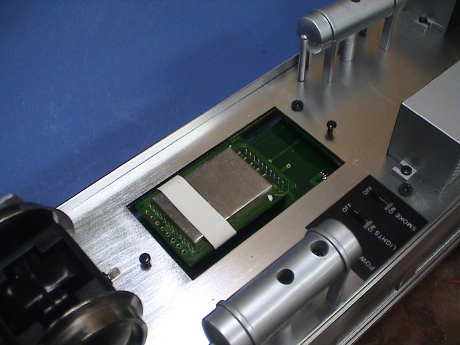 This is an installation of a DG383AR into an AristoCraft RDC. The installation was as easy as loosening two screws, sliding off a cover box, pulling a jumper plug and plugging in the decoder, reinstalling the cover box and retightening the screws. On other locos, either the tender or locomotive shell may have to be removed to access the socket.
This is an installation of a DG383AR into an AristoCraft RDC. The installation was as easy as loosening two screws, sliding off a cover box, pulling a jumper plug and plugging in the decoder, reinstalling the cover box and retightening the screws. On other locos, either the tender or locomotive shell may have to be removed to access the socket.
The DG383AR is adequate for all two motor AristoCraft locos. The DG583AR is intended for four motor locos such as the SD45.
| Locomotive | Link | Notes |
|---|---|---|
| Aristo RDC | DCC Installation in the RDC | Worked fine, still in there. |
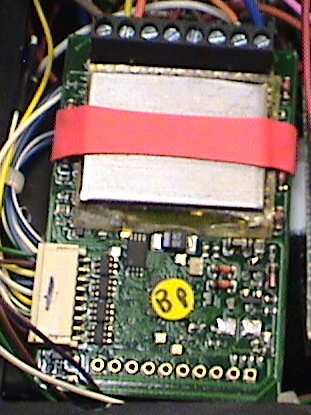 The DG583S is a version of the DG583AR with screw terminals to allow it to be used in applications without the plug and play socket. This is a very capable decoder. I've used several and I've had only one, very exasperating, problem.
The DG583S is a version of the DG583AR with screw terminals to allow it to be used in applications without the plug and play socket. This is a very capable decoder. I've used several and I've had only one, very exasperating, problem.
It is unclear to me what actually happened, but somewhere along the line, somebody changed the headlight definitions for the plug and play socket. They were reversed from the original definition. Digitrax did something to the AR version of the decoder to accommodate this switch. The AR version of the decoder has only the two headlight functions brought out to pins. The rest of them are on a standard 9 pin header on the side of the decoder and coded with "standard" wire colors. However due to the headlight switch on the AR version, the functions of the white and yellow wires (forward and reverse headlight) are ALSO reversed. This caused me quite a bit of grief as the decoder didn't work like it's instruction sheet indicated and I just didn't believe that Digitrax actually screwed up that badly, but they did. The simple solution to this problem is to just use the yellow wire for the front headlight and the white wire for the rear headlight. The functions of the wires can also be swapped by remapping the wires via CV33 and CV34. On the S version of this decoder, the screw terminals DO NOT have the headlight connections so that the headlights must be connected via the white and yellow wires. I do not know if the wire functions are reversed on the AR version as well, but I suspect that they are.
Other than the headlight issue, I've had really good experiences with this decoder, I've used a bunch of them. The motor controller runs silently and the BEMF functions work well. The lighting functions have always worked well on Digitrax decoders. I haven't hit the motor driver really hard yet, that will be coming up shortly. This decoder can also be used to drive Lionel AC motors.
| Locomotive | Link | Notes |
|---|---|---|
| Bachmann Heisler | DCC Installation in the Bachmann Heisler | Eventually worked fine, but had troubles getting the headlights right. Digitrax reversed the yellow and white wires. Subsequent installations went smoothly. |
| Aristo Rogers | DCC Installation in the Aristo Rogers | Decoder mounted in tender for ease of sound integration, no difficulties |
| Bachmann Big Hauler, 3rd and 5th generation | DCC Installation in the Big Hauler | Worked fine. |
| Bachmann Columbia | DCC Installation in the Bachmann Columbia | Decoder mounted in the tender for ease of sound integration, no difficulties |
| LGB 2107 and Powered Tender | DCC Installation in the LGB 2017 and Powered Tender | Decoder mounted in the tender for ease of sound integration, runs both the loco and tender motors. No difficulties. |
| Aristo C-16 | DCC Installation in the C-16 | Mounted in the tender for ease of sound integration. No difficulties |
| Aristo Classic Railbus | DCC Installation in the Classic Railbus | No difficulties |
| Aristo Center Cab | DCC Installation in the Center Cab | Rides alongside a battery/RC system. Works fine. |
| Lionel James | DCC Installation in James | Replaced a blown up MRC AD320 which in turn replaced a blown up DH123 |
| Aristo FA1 | Battery Plus DCC Installation | The DG583S replaced an MRC322 |
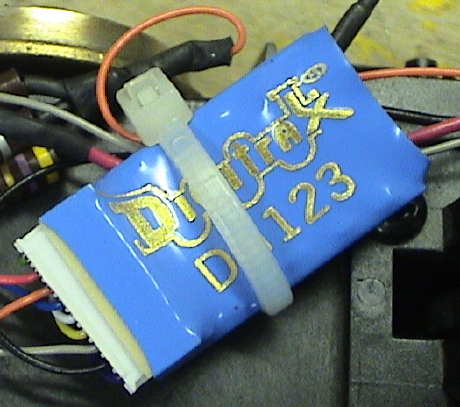 The DH123D is a very basic, and inexpensive, HO sized decoder. It is very small, by large scale standards anyway, and it has a pretty hefty motor driver for it's size. It'll handle 1.5 amps continuously and 2 amps for short peak loads. It has just two functions but the special functions can be applied to these two outputs. It can easily handle a 2nd Generation Big Hauler and some of the lighter weight single motor locos, especially ones that don't have a lot of pulling power anyway.
The DH123D is a very basic, and inexpensive, HO sized decoder. It is very small, by large scale standards anyway, and it has a pretty hefty motor driver for it's size. It'll handle 1.5 amps continuously and 2 amps for short peak loads. It has just two functions but the special functions can be applied to these two outputs. It can easily handle a 2nd Generation Big Hauler and some of the lighter weight single motor locos, especially ones that don't have a lot of pulling power anyway.
| Locomotive | Link | Notes |
|---|---|---|
| Bachmann Big Hauler, 2nd Generation | DCC Installation in the Big Hauler | The HO sized decoder runs this older loco fine due to the small, high speed motor. |
| Lionel Handcar | DCC Installation in the Lionel Handcar | worked fine with a little resistance in series with the motor to limit stall current. |
| Lionel James | DCC Installation in James | Did not use a current limiting resistor on the motor and the DH123 burned up in a couple of minutes. |
| Riverossi HO Dockside | The GIRR HO | This HO loco ran poorly at low speed from straight track power but ran MUCH better after DCC was installed. |
| Athearn HO rubber drive F7B | The GIRR HO | The DH123 did pretty well here but was replaced with a DH163D to take advantage of BEMF |
| Mehano Trolly | The GIRR HO | The DH123 did well in this application. |
The DH163D is a more advanced HO decoder than the DH123. It looks pretty much the same. It has the same 1.5 amp motor driver, but it is internally protected against miswires that connect a motor lead to the track. I has six function outputs instead of two and most important, it has BEMF motor control which works quite well. It's about the same size as the DH123 and costs about $10 more. I've had really good results with this decoder.
| Locomotive | Link | Notes |
|---|---|---|
| Athearn "Classic" HO F7 | The GIRR HO | I actually did two of these locos, one ATSF freight and one ATSF Warbonnet. The Warbonnet loco actually used a special version the DH163AT that had special connections for the Athearn loco. These weren't really needed, a stock DH163D can be used instead for $3 less. |
| Athearn HO rubber drive F7A and F7B | The GIRR HO | The DH163D worked sufficiently better in the rubber drive FA than a DH123 did in a similar B unit that I upgraded the B unit later. |
| Athearn HO SW1500 | The GIRR HO | This is another "classic" Athearn drive loco. The installation was a little tighter but it fit and worked well. |
| Mehano HO Pacific | The GIRR HO | This one was also physically tight, but it worked quite well. The tender eventually got an SFX0416 for sound. |
| Bachmann HO GP7 | The GIRR HO | This was a straight forward installation and it worked well here too. |
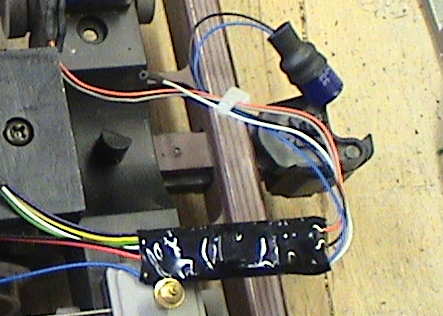 I've used one Digitrax sound and function decoder. I only used the sound part as the motor decoder in a Lehmann Porter was already handling the lights. This decoder comes with a 1" speaker which is really not adequate. I used a better speaker and put it in the smokestack where it could point upward. The sound quality of this decoder is good, but it's volume is marginal, even indoors.
I've used one Digitrax sound and function decoder. I only used the sound part as the motor decoder in a Lehmann Porter was already handling the lights. This decoder comes with a 1" speaker which is really not adequate. I used a better speaker and put it in the smokestack where it could point upward. The sound quality of this decoder is good, but it's volume is marginal, even indoors.
The decoder has an external 330µF capacitor wired to it to provide adequate sound carry over for temporary power dips. The included capacitor seems to do this job adequately.
Note that unless the decoder has some loads wired to it's function outputs, it will not respond on the programming track. It will accept programming but it cannot readback data to the command station. I wired an LED and a 1K resistor to the headlight function to provide the necessary load. This load may be marginally small because the same thing didn't work on the SFX064D. I needed to increase the load current (decrease the resistor, in my case I arbitrarily picked 200Ω) to get the SFX064D to respond.
| Locomotive | Link | Notes |
|---|---|---|
| Lehmann Porter | Sound Installation in the Lehmann Porter | This sound decoder doesn't have enough chuff volume to be heard over the normal running noise of metal wheels on metal rail. Whistle and bell are loud enough, chuff is not. |
| Mehano HO Pacific | The GIRR HO | The SFX0416 got replaced by an SFX064D in the Porter. It got transplanted (after being replaced by Digitrax for a failure to accept sound programming) in the tender of an HO Mehano Pacific. It is marginally loud enough even in an HO loco. |
| USA Trains F3A | USAT F3A Tips | The SFX0416 was removed from the Mehano Pacific and installed, with an audio amplifier, into a large scale loco with good results. |
The SFX0416 has what is called a "playable" whistle which is activated by setting CV150=1. To make it work, a DT400 or better throttle is needed as well with a throttle OPSW#3 set to x80 more than whatever is in there already. The F2 button then becomes pressure sensitive. A light press does the same as it used to, a heavy press causes the throttle to display a bar graph (where the speed would normally be) indicating how hard the button is pressed. This also causes LOTS of LocoNet traffic.
The decoder responds by changing it's volume. It doesn't actually get louder when CV150=1, it gets softer so that it has headroom to get louder as the button is pressed harder. Overall, the effect is less than impressive.
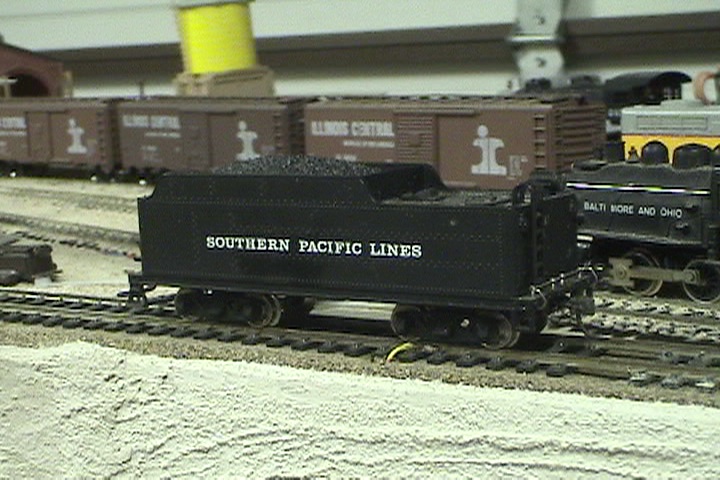
If that movie format (.m4v) doesn't play on your computer, then get a new version of QuickTime or try this link.
I finally just got tired of the SFX0416 in the Mehano Pacific. The volume was so weak that I basically could not hear it if there was any background noise at all. I ripped it out and changed it to an ESU Loksound Select and I was much happier.
The SFX0416 sat in my DCC box for a few weeks. Then I came across a large scale USA Trains F3A at no cost. In a large scale loco intended for use out of doors the SFX0416 would be a ridiculous choice due to the low sound volume, but I had some 1 watt amplifier kits to boost the output and I could use a good speaker. In this role, it worked quite well as shown in this Quicktime video.
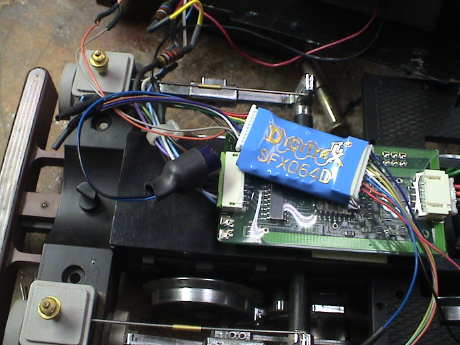 The SFX0416 wasn't working out due to lower than necessary sound volume so I substituted an SFX064D instead. This one uses a 32Ω speaker so the nice high bass 8Ω speaker had to come out. The SFX064D is a slightly older design but it comes with the same generic steam sound program. It did indeed work much better, it is load enough to use, even outdoors.
The SFX0416 wasn't working out due to lower than necessary sound volume so I substituted an SFX064D instead. This one uses a 32Ω speaker so the nice high bass 8Ω speaker had to come out. The SFX064D is a slightly older design but it comes with the same generic steam sound program. It did indeed work much better, it is load enough to use, even outdoors.
All Digitrax sound decoders have the capability of having new sound programs loaded into them, but making the new sound program can be a real difficult task. Programs are loaded via a Digitrax PR3 programmer and a Windows program called SoundLoader. SoundLoader is supplied with the PR3. For Macintosh users, sound programs can be modified to the same limited extent as SoundLoader with the sound loader function of DecoderPro (open source and free from the JMRI project).
Note that unless the decoder has some loads wired to it's function outputs, it will not respond on the programming track. It will accept programming but it cannot readback data to the command station. I wired an LED and a 1K resistor to the headlight function to provide the necessary load like the SFX0416 but it didn't work. The load load was apparently too small because the same thing didn't work on the SFX064D. I needed to increase the load current (decrease the resistor, in my case I arbitrarily picked 200Ω) to get the SFX064D to respond.
| Locomotive | Link | Notes |
|---|---|---|
| Lehmann Porter | Sound Installation in the Lehmann Porter | The SFX0416 came out to be returned to Digitrax because it locked up during an attempt to download a new sound file, so I tried an SFX064D. The consensus on the Internet was that the SFX064D was louder than the SFX0416 and that turned out to be the case. |
Note that the stock steam sound file in Digitrax sound decoders has a chuff issue at high chuff rates. There are two distinct chuff levels in the sound project. It goes CHUFF CHUFF chuff chuff on a 4 beat cadence. This sounds ok at low speeds but at higher speeds, the lower volume chuff seems to vanish and the two louder chuffs merge together giving the decoder a very odd sound. Not all sound projects for this decoder sound the same and there are quite a few out there that others have done. I need to find a better one than the default project.
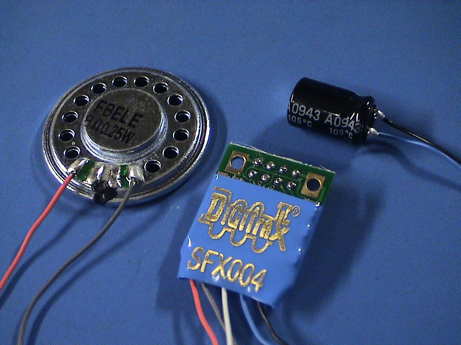
The SFX004 is very similar to the SFX064D except that it has no function outputs AND it is designed to piggyback on some Digitrax decoders in the DH165 family and the DH456. There are 8 pins on the decoder that mate with a socket on the motor decoders, but these are not the same as the 8 pins of the NMRA medium socket. They are on a different spacing and Digitrax says to not use them. The gold pads at the corners are sized to accept a #2-56 thread to mechanically attach the SFX004 to it's parent decoder. These can also be used to connect to a DCC track or power bus to allow the decoder to be used with other kinds of decoders or in stand alone applications.
The programming and performance of this decoder is identical to the SFX064D. The white wire is for a chuff cam.
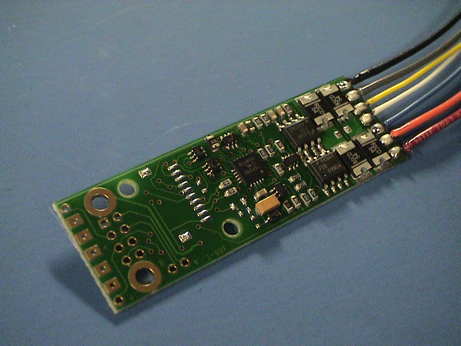 The DH465 is a physically sized to fit inside a tyical HO shell but it is longer than most HO decoders. However the motor drivers are sized to accommodate a much larger loco. The 4 amp capability is right between the DG583AR (which will handle most 2 motor large scale locos) and the DG583AR or S which will handle most 4 motor large scale locos. Neither of the DG decoders will adequately handle the larger USAT locos.
The DH465 is a physically sized to fit inside a tyical HO shell but it is longer than most HO decoders. However the motor drivers are sized to accommodate a much larger loco. The 4 amp capability is right between the DG583AR (which will handle most 2 motor large scale locos) and the DG583AR or S which will handle most 4 motor large scale locos. Neither of the DG decoders will adequately handle the larger USAT locos.
The decoder comes in a wired configuration only.
The DH465 doesn't have the heat sink capability of the larger decoders so that I suspec that it won't handle the transient abuse that the DG series will handle, but it should do well in most applications.
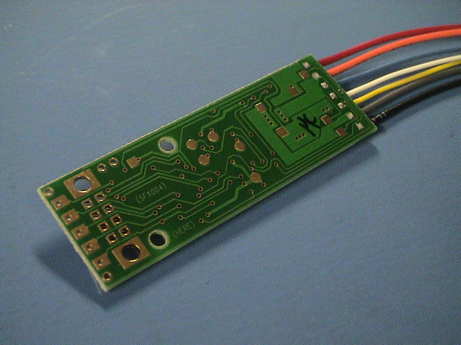 The decoder backside is bare and uninsulated. This means that it will need to be secured such that it cannot touch metal things that might cause problems. It would be best to mount the flat backside against something flat with double sided foam mounting tape.
The decoder backside is bare and uninsulated. This means that it will need to be secured such that it cannot touch metal things that might cause problems. It would be best to mount the flat backside against something flat with double sided foam mounting tape.
The DH465 also has the mounting features for an SFX004 Soundbug sound decoder.
The Digitrax sound decoders described above have downloadable sound projects so any of them can be changed out to a completely new sound. Each project is also editable, with considerable difficulty, to modify what it does or to create completely new sound projects. I won't get into modifying a sound project here as I have not been successful trying it.
The Digitrax web site has a sound library with pre-made project. This QuickTime Movie has a sample of some sound projects, two from Digitrax and two that were homebrewed by somebody else.
To download a new project you need a Digitrax PR3 programmer. I used the Digitrax Soundloader software that comes with the PR3 to drive the programmer. JMRI is supposed to be able to download sounds via the PR3 but I have never seen it work. I ran Soundloader under Windows 7 (the software is PC only) but running under Parallels 5 under Mac OS 10.6.5 on the very first Intel Macintosh. Any Mac that has an Intel processor should be able to do this. The major hassle is that the USB driver software installation in any version of Windows on any PC is somewhat "fragile" in that it might take a couple of install/deinstall cycles to get it to actually work.
I have a caution note however. If you have set a Digitrax sound decoder to use the alternate sound set (CV60=1) in any sound project that actually has an alternate sound set, such as the one that ships with the decoders, THEN you MUST set CV60 back to 0 to play the primary sound set after you load a new project that only has a primary project in it. If you don't, the thing will appear not to work.
[ Home ] [ Up ] [ Previous Page ] [ Next Page ]
This page has been accessed times since 14 Nov 08.
© 2008-2011 George Schreyer
Created 14 Nov 08
Last Updated October 20, 2012